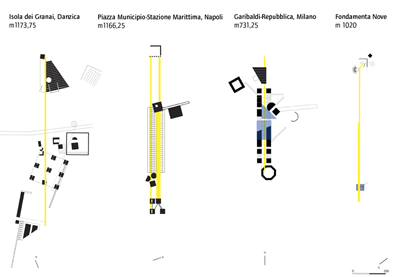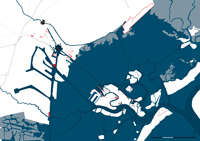You are in: Home page > Magazine Archive > The linear compositions of Gianugo Polesello

Magda Minguzzi
The linear compositions of Gianugo Polesello
If we observe all the projects and
research that Gianugo Polesello dedicated to Venice we immediately come to
realize the importance this city had in the architect’s life.
Venice as origin: from his experience alongside Samonŕ, his membership of the
“School of Venice”, his teaching at the IUAV, the foundation of the Gruppo Architettura (1), the exhaustive
research mostly carried out on the fringes and urban margins.
Hence, Venice as a workshop of studies and investigations, whose results and fundamental principles were to be “tried out” elsewhere.
At the end of the 1980s “Polesellian Venice” was largely completed (Fig 1). The areas figuratively and functionally awaiting definition found their raison d’ętre within the lagoon theatre and Polesello’s attention turned elsewhere for a time.
The years 1989 to 1992 saw one linear project following another for the cities of Danzig, Naples and Milan, to finally return to Venice, for the Fondamenta Nove, in a project that would end up one of his most essential, albeit in some ways obscure. Compositions whose minimum common denominator is once more represented by the urban theme: the margins, the fringes. Places characterised by an absence of content, of urban fabric, of relationships with the surroundings.
Projects/manifestos of an architecture whose roots were sunk in the modern movement.
These extraordinary compositions vie with the contemporary city. Situations of peripheral sprawl, dimensionally dilated, evolved without direction, where the ancient fabric, compact and coherent, at times manages to graze the areas of the intervention.
The city idea referred to is the “open” (2), where Nature penetrates the urban fabric and leads inexorably to the dilatation of open space and the consequent figurative independence of the architectural object.
In these interventions the prevalent dimension is length, which tends to the kilometre (Fig 2). For this reason, the main project axis, which is normally represented by a pedestrian route that runs along its entire length, is the pivot of the composition, the measure with respect to the city, the place to be animated thanks to the introduction of figures, of personages: towers, the glass forum, the odeion, etc. Pure volumes, coming from the Archive of Architecture (3), which, thanks to their arrangement foster the relationship between the man who crosses the project and the city or the elements of the project itself, in a constant toing and froing between interior and exterior, long fields and close-range points of view.
Grids and modules that multiply, rotate, expand. These are the tools, coming from the fascination Polesello had with the Ancient Roman origins of the territory (centuration), with which to “govern” emptiness and arrange the figures of the project.
The raison d’ętre of the indissolubility between compositional and urban theme ‒ almost as if it were a leitmotif ‒ should not be sought in stylistic choices or accidental issues linked to the outline of the site but in a precise desire, an intellectual urgency expressed formally. Thus, as if they were great dykes, these compositions seem to wish to guarantee, through their presence and majesty, the arresting of a phenomenon: the loss of identity and form, of order and hierarchy between the parts which is an expression of the contemporary city, of the suburbs.
This is the greatest lesson these projects communicate to us. This is the road Gianugo Polesello shows us and which seems, in many ways, yet to be undertaken.
Notes
1. The Gruppo Architettura was a collection of IUAV lecturers consisting of Carlo Aymonino, Costantino Dardi, Gianni Fabbri, Raffaele Panella, Gianugo Polesello, and Luciano Semerani.
2. Please see the definition of “open city” by Antonio Monestiroli (1997), Temi Urbani, Unicopli, Milan.
3. The Archive of Architecture is the basis of Polesello’s compositional system: “montage of architecture via architecture”. These are architectural elements from his projects which, over time, he would repropose with minimal variations.
Magda Minguzzi is an architect and PhD in Architectural Composition at the IUAV in Venice.
The article “The Linear Compositions of Gianugo Polesello and the City Limits” has been freely adapted from the PhD thesis of the same name.
















